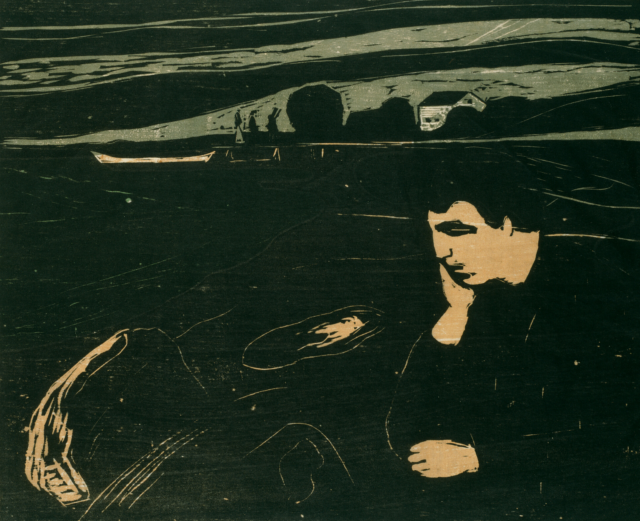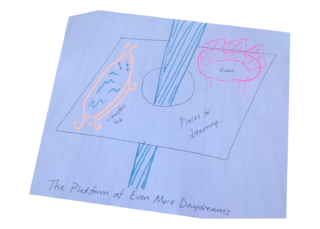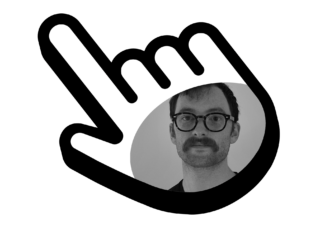
My first diagnosis came from Dorothy, the middle-aged psychologist who I visited every Wednesday after school at our Boston suburb’s Youth and Family Services office. She wore rose-colored lipstick and statement necklaces, and though her eyes were soft and kind, her demeanor was business-like. I’d been referred to Youth and Family Services by my eighth-grade guidance counselor after showing up to school with a neat lattice of thin scars on my legs and upper arms. It was late fall of 2010; I was thirteen years old, angular and skittish, with a thick curtain of brown hair and heavy eye makeup behind my glasses.
At the end of our sessions, Dorothy would sometimes ask if I had any questions, and eventually, after more than a month of afternoons spent sitting in on the plush chair across from her, I said aloud what I had been wondering from the moment I first stepped into her office.
“What do you think I have?”
“What do you mean?” she asked.
“Like, a diagnosis.”
She leaned forward. “I would say you have what we call an adjustment disorder.” I nodded solemnly with my hands clasped, as if I understood what this meant.
Adjustment disorder, I learned from a Google search later that evening, is characterized in the Diagnostic and Statistical Manual of Mental Disorders (DSM) by an unhealthy or excessive response to a stressful event. In order to qualify, symptoms must persist for at least three months afterward, and cause significant problems in a person’s work, school, or social life.
The label makes as little sense to me now as it did then. My distress hadn’t been precipitated by any particular event — there had been no parental divorce, no death in the family, no abuse or trauma. There wasn’t even a “before” from which to contrast this supposedly recent “after” — my whole life, or as much of it as I could remember, had been punctuated by mood swings, uncontrollably anxiety, depressive spells, and panic attacks. I never brought up the subject of diagnosis again with Dorothy; in fact, for the rest of my time at the Youth and Family Services office, I stopped asking questions altogether.
I thought of Dorothy for the first time in many years while reading an early copy of Rachel Aviv’s debut nonfiction book, Strangers to Ourselves: Unsettled Minds and the Stories that Make Us, which Farrar, Straus & Giroux will publish next week. Strangers to Ourselves is a suite of six psychiatric patient case studies whose subjects differ in age, race, religion, and economic background. Two things unite them: first, they have each left behind extensive journals or memoirs, allowing Aviv to meticulously reconstruct scenes from their lives; second, they each belong to what she terms the “psychic hinterlands,” realms of experience that prod against contemporary assumptions about mental illness and its treatment.
One of these subjects, notably, is Aviv herself. With the help of interviews, her mother’s diary, and medical records, she recounts having been hospitalized for an eating disorder at the age of six, the youngest anorexia case her doctor had ever seen. In the pediatric eating disorders unit, Aviv befriends two twelve-year-old girls, Carrie and Hava, who measure themselves “not just in pounds, but in ounces, too.” After a few weeks in the hospital, Aviv begins eating again, and is released; here her life story diverges from that of Hava, who continues to struggle with a severe eating disorder in and out of hospital settings until her death at forty-three. Hava’s life, probed through interviews with family members and access to her diaries, looms over Aviv. “It’s startling,” she says, “to realize how narrowly we avoid, or miss, living radically different lives.”
In considering her past, Aviv develops a theory as to why she, unlike Hava, was able to quickly recover from her brush with mental illness: having been too young to understand her diagnosis, anorexia didn’t become a part of her identity in the way it did for Hava. “I never felt stuck in a particular story that others had created for me,” she says. “I had the freedom to get bored of my behavior and to move on. It wasn’t until middle school, when I had friends who were experimenting with anorexia, that I grasped the kinds of meanings that the diagnosis carried. But by then the illness no longer felt compelling.”
Aviv’s interest lies in the narrative weight of diagnosis, an aspect of living with mental illness which, per her thesis, affects the course of patients’ lives as much as treatment — or perhaps even more. The potential meanings of psychiatric diagnosis refract out and away from one another like light from a prism — a benchmark to guide treatment, a numeric code on a health insurance document, a pretense to enact violence on the vulnerable — but for Aviv, they are stories, first and foremost, sizzling with equal potential to heal or to harm. “People can be freed by these stories,” she says, “but they can also get stuck inside them.”
In the twelve years since receiving my first diagnosis, I’ve remained a dutiful patient, having seen at least a dozen therapists and psychiatrists across the four states in which I’ve lived throughout my teenage and adult years. Their offices are interchangeable: neutral tones, calming landscapes or nature photography on the wall, bookcases lined with titles laden in relentlessly positive therapy-speak. What differs, sometimes substantially, is these professionals’ assessment of what is wrong with me. The list of diagnoses I’ve received currently includes major depression, generalized anxiety disorder, obsessive compulsive disorder, attention deficit hyperactivity disorder, a learning disability, and, of course, adjustment disorder. I’ve never received a bipolar disorder diagnosis, but two of my past psychiatrists prescribed me the mood stabilizers typically given to treat it, suspecting that I may be presenting atypically. Once, after requesting my medical records, I discovered that an emergency room doctor had labeled me a “possible borderline personality disorder case” after speaking with me for less than twenty minutes. I’ve received some diagnoses I consider basically indisputable, and others I’m sure are dead wrong; some have taken me by surprise, while others I have subtly engineered (the symptoms I reported in order to get my Ritalin prescription were not necessarily untrue, but presented in a rehearsed, clear-cut fashion; I wanted the Ritalin to boost my productivity in grad school). I live within and among diagnoses, and yet I find myself increasingly unsure of what to make of them, or what they should mean to me.
All the while, as I’ve accumulated punches on my diagnostic card, there’s been a strange if perhaps unsurprising shift in the broader culture. Instances of mental illness are on a steady rise in the United States, while certain forms of illness, like depression and generalized anxiety, have become gradually less stigmatized; we are more aware and accepting of the psychopathological model than ever before, and as such, we view ourselves and those around us in increasingly psychopathological terms. On Twitter, I rarely go a day without encountering a lengthy thread enumerating the symptoms of ADHD “they don’t tell you about,” or a “gentle reminder” that various disorders present differently in men and women. On TikTok, teenagers and spiritually teenaged thirty-somethings dance behind walls of text: “a day in the life with bipolar disorder”; “things I thought were bad personality traits that were actually BPD.” (In the comments of these videos is an echoing refrain of stunned recognition: “oh my god, this is me!!”) Logging off only provides so much distance from the swirl of taxonomy. An acquaintance who regularly misses social cues, I’m told over lunch, is possibility an undiagnosed Asperger’s case; a person who has behaved cruelly toward me, I counter, is a “textbook” narcissist; the man shouting incoherently on the subway is a schizophrenic (we recognize labeling him this way as more appropriate than using a pejorative, like “crazy person,” but in doing so, we condescendingly presume to understand the condition of a complete stranger).
This conflation of pathology and identity is disconcerting, to say the least — and still, it feels unfair to completely dismiss the perspective of those earnestly spreading #awareness. Receiving a diagnosis — an explanation, or even a simple acknowledgement, of a potentially lifelong struggle — is often a tremendous source of comfort. This is perhaps the foremost theme of diagnosis-related Twitter and TikTok content: labels deliver people from the shame of what they’d previously believed to be a damning character flaw, while connecting them to a legion of others with similar challenges. “A diagnosis is comforting because it provides a framework — a community, a lineage — and, if luck is afoot, a treatment or cure,” writes Esmé Weijun Wang in The Collected Schizophrenias, her essay collection about living with schizoaffective disorder. “A diagnosis says I’m crazy, but in a particular way.” (Similarly, Hava notes in her diary that “labels aren’t so bad. They at least give you a title to live up to… and an identity!!!!”)
Diagnosis provides one of Aviv’s other subjects with this kind of solace. Laura, a “golden girl” born to a wealthy and blue-blooded Connecticut family in the early eighties, tells Aviv she spent her youth achieving at the highest levels scholastically, athletically, and socially, all while harboring a secret, gnawing emptiness at her core. While attending Harvard, she sees a psychiatrist at a renowned hospital, who tells her she is suffering from bipolar disorder. Laura feels a rush of relief, immediately recognizing herself in her psychiatrist’s description of the illness. “The psychiatrist told me who I was,” she says, “in a way that felt more concrete than I’ve ever conceptualized before.”
This positive narrative force of diagnosis — the relief, the empowerment, the liberation from shame — appears tightly bound up with the medical authority of the diagnostician. Anyone can offer you a narrative explanation of your psychic pain, and any number of these explanations might hold some genuine insight, but a doctor’s explanation carries a specific cultural weight, suffused with misbegotten beliefs about the nature of Western medicine: that it is apolitical; that it is static (except when it advances, and it only ever advances); that it is unimpeachably objective in its methods and findings. Laura gladly accepts a slew of prescriptions from her psychiatrist, Aviv says, each one serving as evidence of the validity of her pain. The pills don’t work, so she’s prescribed more and more, until she is drowning in prescriptions, many of them intended to relieve the side effects of others, all the while still feeling utterly dead inside. She becomes well-versed in bipolar disorder’s symptoms and cycles, obsessively attributing every minor fluctuation in her mood or behavior to the illness and reporting it to her psychiatrist — desperate, Aviv says, for “confirmation from experts to make her unhappiness feel real.” With her vigilant taxonomizing and appeals to medical authority as a source of personal comfort, she is not dissimilar from people who turn their diagnoses into TikTok content. Both are heavily invested in a medicalized narrative of their lives. What’s more, they are also deeply attached to the promise of the diagnostic process: of hidden truths, biologically rooted and ontologically stable, uncovered by the shrewd detective work of beneficent medical professionals — of labels as a tool for clarity, and of clarity as a tool for healing.
Here’s another story about diagnosis: it is inextricable from the cultural norms and proscriptions that shape it, and, in the hands of those endowed with medical authority, a tool of social control. Some examples are widely remembered, such as the inclusion of homosexuality in the DSM from its first edition in 1952 until 1973. For centuries before that, “female hysteria” was thought to explain all manner behavior in women deemed troublesome by their husbands and families; its spiritual successor, arguably, is borderline personality disorder, a condition characterized by extreme mood swings, unstable relationships, and impulsive behavior that is diagnosed three times more often in women than in men. Racism, too, has held a tight grip on the evolution of psychiatry. Aviv notes that while many psychiatrists once believed Black people were immune from “insanity,” the 1840 census, in its attempt to count the insane population, found that free Northern Black people were eleven times more likely to be deemed insane than enslaved Southern Black people — and the desire to escape bondage, several psychiatrists theorized, must itself be a product of mental illness. Today, racial bias continues to play a large role in diagnostic outcomes: in the United States, Black people are diagnosed with schizophrenia — a highly stigmatized illness associated in the cultural consciousness with violence and instability — at a higher rate than white people, while being comparatively underdiagnosed with mood disorders. (For further reading on psychiatric bias in relation to race, gender, and sexuality, I recommend (Mis)Diagnosed: How Bias Distorts Our Perception of Mental Health by Jonathan Foiles.)
This is not to say that psychiatry wholly lacks scientific merit, but rather that the question of who is mentally ill, and how or why, is political and cultural as well as medical. The boundaries of diagnosis, like district borders that heighten the appearance of coherence within and difference between, are constantly being redrawn. Criteria are altered, new disorders are created or abolished, and conditions previously considered distinct are combined, for reasons having as much to do with cultural context as new medical insight. With all of this in mind, our cultural moment’s credulousness toward diagnostic categories — and, by extension, the medical authority underpinning them — is alarming. But if taking these categories at face value can be dangerous, how instead should we relate to diagnosis?
One possible answer came from “antipsychiatry,” an oppositional school of thought that arose within psychiatry in the sixties and seventies. In its foundational text, The Myth of Mental Illness, the psychiatrist Thomas Szasz argues against the very concept of mental illness. According to Szasz, it is the surreal and dehumanizing nature of modern society rather than “innate” matters of biochemical dysfunction that causes insanity and psychic pain, and its supposed treatment amounts to a scheme to enact social control. While many of antipsychiatry’s most enthusiastic supporters held libertarian politics, its ideas also found an audience within the New Left, advanced by psychiatrists such as R.D. Laing and David Cooper. Mainstream psychiatric theorists, for their part, largely ignored the movement, or dismissed it as little more than a conspiracy theory.
Half a century later, the most visible advocates for antipsychiatry-descended perspectives are themselves current or former psychiatric patients. Advocacy organizations, web publications such as Mad In America, and support groups for “psychiatry survivors” have connected people across the world in sharing testimony of rejecting labels and treatment. One of these advocates, incredibly, is Aviv’s subject Laura. At the age of twenty-seven, Aviv explains, Laura happened upon a copy of Anatomy of an Epidemic, a book by Mad In America founder Robert Whitaker that argues against the long-term prescription of psychotropic medications. At this point in her life, she took six separate psychiatric drugs, slept up to fourteen hours a day, and continued to feel emotionally numb. After corresponding with Whitaker and reading more antipsychiatry texts, Laura did the seemingly unthinkable — she gradually weaned herself off of every last medication. She began to flourish. “I’m off of all these drugs,” she tells her former psychiatrist, “and I’ve never felt more vibrant and alive and capable, and yet I had this serious mental illness. How do you make sense of that?” The psychiatrist cannot.
Today, Laura is an advocate for other patients hoping to leave treatment behind, bringing ex-patients together to guide people through the often-harrowing process of psychiatric drug withdrawal. Her belief in the power of rejecting diagnoses and medications is unflagging; when Aviv tells her that she struggled while briefly off of her Lexapro during a pregnancy, and feels that the drug positively impacts her quality of life, Laura suggests that she simply needs to try a slower withdrawal. To Aviv, it appears that Laura’s formation of identity around an unequivocal rejection of her diagnosis and treatment shares a similar reductiveness with her embrace of it years prior. “One explanation,” she says, “was still holding too much power.”
So while Strangers to Ourselves occupies a decidedly psychiatry-critical perspective, Aviv is unconvinced by the hardline rejection of all psychopathology represented by theorists like Thomas Szasz. His belief that mental distress can be solely explained through social factors rather than biological ones, she says, “diminishes the reality of mental disability.” Any person who attempts to answer the question “Am I the insane one, or is it society?” — whether they come down on the side of biological or social factors — “presumes the impossible: that the self can be divorced from the society that shapes it.”
I, too, am ambivalent. The psychiatric labels I’ve been offered for my own pain feel patently inadequate, as I suspect they are on some level for most people. But I’ve also seen too many lives utterly transformed by treatment — suffering that once seemed boundless and immutable, dissolved in weeks or even days with a diagnosis and its corresponding medication — to believe that mental illness is entirely void of biological factors. And the siloing of symptoms into diagnostic boxes, while bordering on ludicrous in cases like mine (no, I do not believe that I am simultaneously suffering from four or five separate disorders), isn’t without medical value: if patients diagnosed with unipolar depression tend to respond to a different class of medication than those with bipolar disorder, the distinction is, at least for treatment purposes, helpful.
To what extent, then, might it be possible to disentangle diagnosis’ potential to heal from its potential to harm — to keep what is helpful about the diagnostic framework while rejecting what is not? This is partially a question of culture: of a vibe shift, if you will, away from veneration of the psychopathologic model. On and adjacent to the political left, the tenor of discussion has recently turned more skeptical of our hyperdiagnostic moment: writing for Gawker, James Greig notes the “overriding air of bourgeois whimsy” among ADHD TikTokers, while P.E. Moskowitz describes capitalism as hawking diagnoses like microtargeted clickbait in “The BuzzFeedification of Mental Health.” Measured criticism such as Strangers to Ourselves will perhaps be a key entry to this shift, charting a path between wholesale rejection of diagnostic intervention and uncritical acceptance of its methods and consequences.
But it is also a material question, one of wresting away some power from the system of medical authority that legitimizes diagnoses. The logics of our healthcare system demand that where care is offered, there must necessarily be affliction: it is virtually impossible to seek treatment for psychic distress without having that distress medicalized in the form of a diagnosis. The trouble with psychiatry’s development as a medical science is that while there are, in truth, no clear boundaries between the sort of psychic distress mostly attributable to social factors and that which is mostly attributable to biological ones — of what mental health care professionals might deem “non-medical” versus “medical” distress — the field demands a dichotomy. “Is psychiatry a medical enterprise concerned with treating diseases,” Szasz poses in Insanity: The Idea and Its Consequences, “or a humanistic enterprise concerned with helping persons with their personal problems? Psychiatry could be one or the other, but it cannot — despite the pretensions and protestations of psychiatrists — be both.”
But couldn’t it be both? We know pharmaceutical interventions can benefit both medical (“diseases”) and nonmedical issues (“personal problems”), and that humanistic interventions, too, can benefit both medical and nonmedical issues. A patient might feel more free to either claim or walk away from a medical diagnosis — to seek out the truth of their condition — if the diagnosis was not a prerequisite for receiving treatment (and insurance coverage). Is it so inconceivable that I could pursue a Ritalin prescription not on the basis of having ADHD (I doubt that I do), but rather, because it positively impacts my mental health and functioning? That my health insurance should pay for weekly therapy not because I am suffering from a nameable condition, but simply because I benefit from it? In practice, some medical practitioners and savvy patients have already learned to circumvent the rigidity of the mental health care system. But the diagnostic framework still looms over patients of psychiatry, the ready-made narratives of psychopathology applied to us being, for now, the cost of receiving treatment.
Since reading Strangers to Ourselves, I’ve found myself wondering why I asked Dorothy about my diagnosis those many years ago. I relate to my own diagnoses with varying degrees of skepticism, yet I am undeniably attached to something greater than the sum of those parts — to an identity shaped by mental illness. To look at my life story, at my struggles and countless failures, without that narrative frame feels like a complete reinvention: I am rendered a “stranger to myself,” as Hava refers to herself in a diary entry. The prospect terrifies and compels me in equal measure. For while I have never experienced the transcendent rush Laura describes to Aviv when recounting her initial diagnosis — of having my inner life reflected back to me with all-encompassing precision — a part of me has never given up hope that such a diagnostic salvation is just around the corner, in the hands of the right psychiatrist or page of the DSM, waiting for me. Another part of me is certain this will never be, and that it is likely for the best.
Perhaps, like Laura, I yearned at thirteen to be told who I was, in terms that absolved me of the tremendous guilt I felt for my perceived dysfunction. I wish I could tell my younger self what seems obvious to me now: that such absolution need not require a diagnosis. It is a gift we can offer ourselves freely, no medical degree required.


